Auto Climbing Bracket ACB-100&ACB-50 for formwork and scaffolding system
- Loading Port:
- Tianjin
- Payment Terms:
- TT OR LC
- Min Order Qty:
- 50 m²
- Supply Capability:
- 1000 m²/month
OKorder Service Pledge
OKorder Financial Service
You Might Also Like
Auto-climbing Bracket ACB100 & ACB50
The power of the auto-climbing formwork is the hydraulic system, which includes the oil cylinder
and two commutators. The commutators can control the climbing of climbing rail and the bracket.
The steel rail and the bracket can inter-climbing, so the whole system will climb up steadily.
Cranes are not needed during the construction. It’s easy to operate, highly efficient and safe. It’s
the best choice for the construction of high buildings and bridges.
There are mainly two types of standard auto-climbing brackets, ACB-50 and ACB-100, the figure
means the push power of cylinder with unit of KN.
Characteristics:
◆ Perfect load bearing anchor system
Anchor system is the most important supporting part. The system is made of five parts shown
below. Thereinto, tensile bolt, V-climbing cone and washer can be taken out for reusing after the
concrete pouring finished.There are two kinds of anchor systems,A & B. A is matched with single
anchor shoe and B is matched with double anchor shoe.
◆ Crane-independent
Crane-independent forming, striking and climbing speeds up the work procedures on the
construction site and also makes them independent of each other. This means the planned
sequences can be maintained along with guaranteeing high productivity levels. The crane can
therefore be used for other tasks.
Hydraulic system is mainly made of two commutators,
oil cylinder and power distribution system.The
commutators can control the climbing of climbing rail
and bracket.
◆ High bearing capacity and safe
The stable working platforms are able to carry large loads, e.g. the storage of reinforcing steel
for the next climbing section. Generously-sized working platforms, the well thought-out design for
handling very high wind loads and the patented control function of the climbing mechanism are
some of the special details contained within the comprehensive safety concept.
◆ Platforms adjusted to suit the angle of inclination
The horizontal working areas thus created provide safe and comfortable conditions for
reinforcement work, shuttering and striking, concreting and finishing.
◆ The ACB formwork system can climb not only vertically but also slantways, the largest angle is
18 degrees.
◆ The system can climb up wholly or separately. The climbing process is steady, synchronous
and safe.
◆ The bracket will not fall to the ground until the construction is finished, the field will be saved
and the impacting breakage will be reduced (especially the panel).
◆ The system will furnish omnidirectional platform, the construction organizations don’t need to
set up additional operation platform.
◆ The error of structure construction is small and easy to correct.
◆ The climbing speed is fast, the construction course will be quickened.
◆ The formwork can climb itself and cleaning work can be done in the same situs , the used times
of tower crane will be greatly reduced.

- Q: How does steel formwork affect the structural integrity of a building?
- Steel formwork can greatly enhance the structural integrity of a building. Its rigid and durable nature ensures accurate and consistent placement of concrete, resulting in a stronger and more reliable structure. The use of steel formwork also allows for greater flexibility in design, enabling complex architectural features and reducing the need for additional support elements. Overall, steel formwork plays a crucial role in ensuring that a building maintains its structural stability and meets the required safety standards.
- Q: Can steel formwork be used for underground tunnels?
- Underground tunnels can indeed utilize steel formwork. This material, known for its versatility and durability, is widely employed in various construction endeavors, including underground tunnel projects. Its capacity to withstand the immense pressure and forces from the surrounding soil and rock renders it an ideal choice for tunnel construction. Furthermore, the ease of assembly and disassembly of steel formwork ensures efficient construction and upkeep of tunnels. Given its robustness and resilience, it is no surprise that steel formwork remains a favored option for constructing underground tunnels, guaranteeing a dependable and enduring solution.
- Q: Can steel formwork be used in sports facility construction projects?
- Yes, steel formwork can be used in sports facility construction projects. Steel formwork is a versatile and durable option that offers several advantages. Firstly, it provides a high level of strength and stability, making it suitable for large-scale structures like sports facilities. Steel formwork can withstand heavy loads and pressures, ensuring the integrity and safety of the construction. Additionally, steel formwork is highly reusable, which can significantly reduce construction costs and waste. It can be easily dismantled, cleaned, and reassembled for future projects, making it a sustainable choice for sports facility construction. Moreover, steel formwork allows for precise and accurate construction. Its rigidity and dimensional stability ensure that the desired shape and dimensions of the sports facility are achieved. This is particularly important in sports facilities where precise measurements and uniformity are crucial for proper functionality. Furthermore, steel formwork provides a smooth and uniform surface finish. This is essential in sports facilities where the playing surface needs to be even and consistent to ensure fair gameplay and prevent injuries. In summary, steel formwork is a suitable option for sports facility construction projects due to its strength, reusability, precision, and smooth surface finish. It offers numerous benefits and can contribute to the successful completion of sports facilities.
- Q: Can steel formwork be used for architectural concrete slabs?
- Architectural concrete slabs can indeed utilize steel formwork. When compared to other formwork materials, steel formwork boasts numerous advantages in terms of its strength, durability, and versatility. By providing a rigid structure, it can effectively withstand the pressure exerted by fresh concrete, thereby guaranteeing accurate and precise placement of the slabs. Moreover, steel formwork can be conveniently reused multiple times, rendering it both cost-effective and environmentally friendly. Its smooth surface further contributes to the attainment of high-quality finishes for architectural concrete slabs. Nevertheless, it remains crucial to ensure proper insulation and the use of release agents to prevent heat transfer and potential concrete adherence issues caused by the steel. All in all, steel formwork proves to be a dependable and efficient choice for the creation of architectural concrete slabs.
- Q: What are the considerations when designing steel formwork for high-rise buildings?
- When designing steel formwork for high-rise buildings, it is important to consider several key factors: 1. Load-bearing capacity: High-rise buildings experience significant vertical and lateral loads. Therefore, the steel formwork must be able to support the weight of the concrete and any additional loads, such as equipment or workers. 2. Structural stability: The design of the steel formwork should ensure structural stability during the construction process. This involves considering factors like building height, wind loads, and the possibility of earthquakes. Proper bracing and reinforcement are necessary to maintain formwork stability. 3. Durability: High-rise buildings often have longer construction periods, so the formwork must be able to withstand prolonged exposure to concrete, weather conditions, and repetitive use. To enhance durability, the steel formwork should be designed with corrosion-resistant materials and protective coatings. 4. Flexibility and adaptability: High-rise buildings often have complex architectural designs and irregular shapes. Therefore, the formwork system should be flexible and adaptable to accommodate variations in geometry. This allows for efficient construction and minimizes the need for custom-made components. 5. Safety: Safety is of utmost importance when designing steel formwork for high-rise buildings. The formwork should be designed to prevent accidents and ensure the well-being of workers. Safety features such as guardrails, toe boards, and safe access points should be incorporated. 6. Ease of assembly and disassembly: Assembling and disassembling formwork for high-rise buildings can be labor-intensive and time-consuming. To streamline the construction process, the formwork system should have easy-to-use connections, standardized components, and clear assembly instructions. 7. Cost-effectiveness: High-rise construction projects often have limited budgets. Therefore, the design of the steel formwork should take into account its cost-effectiveness. This includes considering the potential for formwork reuse, minimizing the need for additional support structures, and optimizing the use of materials. By carefully considering these factors, designers can ensure that the steel formwork for high-rise buildings is strong, safe, durable, and cost-effective, enabling the successful construction of these complex structures.
- Q: What are the common cost-saving strategies when using steel formwork?
- There are several common cost-saving strategies when using steel formwork in construction projects. 1. Reusability: One of the key advantages of steel formwork is its ability to be reused multiple times. By properly maintaining and storing the formwork after each use, it can be used for several projects, reducing the need for new formwork and ultimately saving costs. 2. Durability: Steel formwork is known for its durability and long lifespan. It can withstand high pressures and can be used for a longer duration compared to traditional formwork materials like timber. This durability reduces the need for frequent repairs or replacements, leading to cost savings in the long run. 3. Efficiency: Steel formwork allows for faster and more efficient construction compared to traditional formwork methods. The ease of assembly and disassembly, along with the use of hydraulic systems, enables faster construction cycles and reduces labor costs. Additionally, the precision and accuracy of steel formwork ensure minimal material wastage, further contributing to cost savings. 4. Safety: Steel formwork offers enhanced safety features compared to other formwork materials. It provides stability and structural integrity, which reduces the risk of accidents during construction. A safer working environment means lower insurance costs and potential legal liabilities, resulting in cost savings. 5. Reduced labor costs: Steel formwork is typically lighter and easier to handle compared to other materials. This reduces the number of workers required for installation and removal. Additionally, the speed and efficiency of steel formwork result in reduced labor hours, leading to cost savings. 6. Lower maintenance costs: Steel formwork requires minimal maintenance compared to other formwork materials. Regular cleaning and proper storage are typically sufficient to maintain its performance. This eliminates the need for expensive maintenance or repairs, resulting in cost savings over time. 7. Improved quality: Steel formwork ensures consistent quality in construction. It provides accurate dimensions and smooth finishes, reducing the need for additional finishing work. This saves both time and money, as there is no need for additional materials or labor to rectify imperfections. Overall, the common cost-saving strategies when using steel formwork revolve around its reusability, durability, efficiency, safety, reduced labor costs, lower maintenance costs, and improved quality. By considering these strategies, construction projects can optimize their budget and achieve significant cost savings.
- Q: What are the different types of connections used in steel formwork construction?
- There are several types of connections used in steel formwork construction, each serving a specific purpose. 1. Bolted connections: These are the most common type of connection used in steel formwork construction. Bolted connections involve using bolts, nuts, and washers to secure two or more steel formwork components together. This type of connection provides a strong and rigid joint, and it is relatively easy to assemble and disassemble. 2. Welded connections: Welded connections involve fusing two or more steel formwork components together using heat and pressure. This type of connection is often used for permanent structures or where a high level of strength and rigidity is required. Welded connections are typically more time-consuming and require skilled labor. 3. Clamped connections: Clamped connections involve using clamps or brackets to hold steel formwork components together. This type of connection is often used for temporary structures or where frequent disassembly and reassembly is required. Clamped connections are quick to assemble and disassemble and do not require specialized skills or equipment. 4. Interlocking connections: Interlocking connections involve using specially designed interlocking mechanisms to connect steel formwork components. These connections often include tabs, slots, or grooves that fit together, providing a secure and stable joint. Interlocking connections are commonly used in modular formwork systems, where quick and easy assembly is required. 5. Adhesive connections: Adhesive connections involve using epoxy or other adhesive materials to bond steel formwork components together. This type of connection provides a seamless and smooth joint, and it is often used for architectural or decorative purposes. Adhesive connections require proper surface preparation and curing time to achieve maximum strength. Overall, the choice of connection type in steel formwork construction depends on factors such as the desired strength and rigidity, the type of structure being built, the level of reusability, and the available resources and expertise. It is important to select the appropriate connection type to ensure the safety and stability of the formwork system.
- Q: How does steel formwork affect the overall project budget and cost control?
- Steel formwork can have a significant impact on the overall project budget and cost control. Firstly, steel formwork is a durable and reusable option compared to traditional timber formwork. This means that the initial investment in steel formwork may be higher, but it can be used for multiple projects, resulting in long-term cost savings. Additionally, steel formwork offers greater accuracy and precision, resulting in reduced material wastage and labor costs. The precise dimensions and alignment provided by steel formwork lead to improved quality and faster construction, reducing the overall project duration and associated costs. Moreover, steel formwork is known for its strength and stability, allowing for higher concrete pouring rates and larger pour sizes. This increases productivity and decreases the required labor, which in turn positively affects the project budget. Furthermore, steel formwork requires less maintenance and repairs, reducing ongoing expenses. Unlike timber formwork, steel formwork is not susceptible to rot, warping, or damage caused by insects, weather, or repetitive use. The longevity and durability of steel formwork contribute to minimizing replacement and repair costs. However, it is important to consider that steel formwork may require specialized skills and equipment for installation and removal. This can impact the labor costs and require additional training or hiring of experienced workers, which should be factored into the project budget. In conclusion, the use of steel formwork can positively affect the overall project budget and cost control through its durability, reusability, accuracy, efficiency, and reduced maintenance requirements. While the initial investment may be higher, the long-term benefits, including reduced material wastage, improved quality, increased productivity, and decreased repair costs, make steel formwork a cost-effective choice for construction projects.
- Q: Can steel formwork be used for heritage restoration projects?
- Indeed, heritage restoration projects can utilize steel formwork. Steel formwork possesses various advantages that render it appropriate for such endeavors. To begin with, steel formwork exhibits remarkable durability, enabling it to withstand the demanding nature of restoration work. Moreover, it can be employed repeatedly, thereby presenting a cost-effective option over the long term. Furthermore, steel formwork ensures exceptional stability and structural integrity, guaranteeing the solidity and safety of the restored heritage structure. Additionally, it allows for precise shaping and detailing, elements that are fundamental in restoring heritage buildings to their original design and aesthetics. Lastly, steel formwork can be effortlessly tailored to suit the unique specifications of each restoration project. All in all, steel formwork is a dependable and efficient choice for heritage restoration projects.
- Q: How does steel formwork handle different concrete mix designs?
- Steel formwork is highly versatile and can handle different concrete mix designs effectively. The strength and durability of steel make it a suitable choice for accommodating a wide range of concrete mixes. One advantage of steel formwork is its ability to withstand the pressure and weight of different concrete mix designs. Whether it is a high-strength mix or a mix with a higher water-cement ratio, steel can handle the load and prevent any deformation or collapse. This makes it an ideal choice for projects with customized concrete mixes. In addition, steel formwork provides a smooth and even surface finish to concrete structures, regardless of the mix design. This is crucial for achieving the desired aesthetic appearance of the finished product. Steel formwork ensures that the concrete is properly contained and does not leak or spill during the pouring process, resulting in a consistent and uniform finish. Furthermore, steel formwork can be easily adjusted or modified to accommodate changes in concrete mix designs. It is highly adaptable and can be customized to suit the specific requirements of each project. This flexibility allows for efficient construction processes and minimizes the need for additional formwork materials. Overall, steel formwork is a reliable and efficient choice for handling different concrete mix designs. Its strength, durability, and adaptability make it an ideal solution for construction projects that require customized concrete mixes. Whether it is a high-strength mix or a mix with specific properties, steel formwork can effectively handle the demands of various concrete designs.
Send your message to us
Auto Climbing Bracket ACB-100&ACB-50 for formwork and scaffolding system
- Loading Port:
- Tianjin
- Payment Terms:
- TT OR LC
- Min Order Qty:
- 50 m²
- Supply Capability:
- 1000 m²/month
OKorder Service Pledge
OKorder Financial Service
Similar products
Hot products
Hot Searches



















